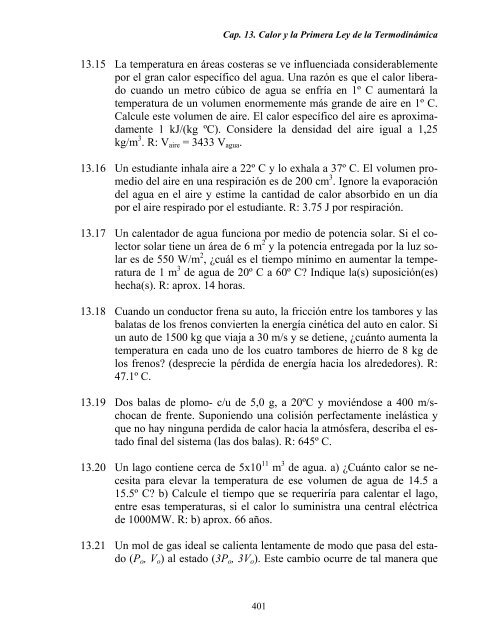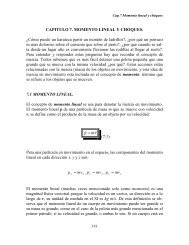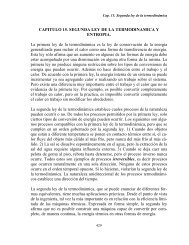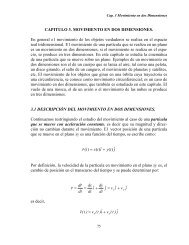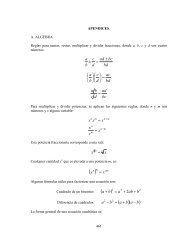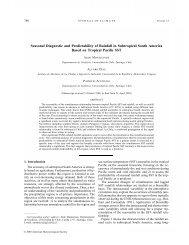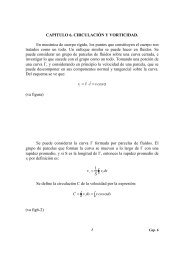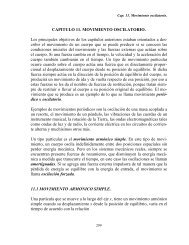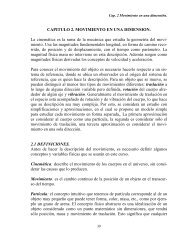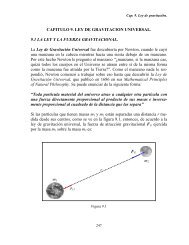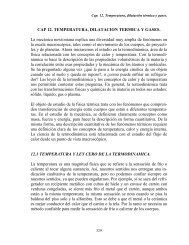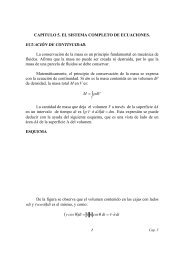Capítulo 13. Calor y la primera ley de - DGEO
Capítulo 13. Calor y la primera ley de - DGEO
Capítulo 13. Calor y la primera ley de - DGEO
You also want an ePaper? Increase the reach of your titles
YUMPU automatically turns print PDFs into web optimized ePapers that Google loves.
Cap. <strong>13.</strong> <strong>Calor</strong> y <strong>la</strong> Primera Ley <strong>de</strong> <strong>la</strong> Termodinámica<br />
<strong>13.</strong>15 La temperatura en áreas costeras se ve influenciada consi<strong>de</strong>rablemente<br />
por el gran calor específico <strong>de</strong>l agua. Una razón es que el calor liberado<br />
cuando un metro cúbico <strong>de</strong> agua se enfría en 1º C aumentará <strong>la</strong><br />
temperatura <strong>de</strong> un volumen enormemente más gran<strong>de</strong> <strong>de</strong> aire en 1º C.<br />
Calcule este volumen <strong>de</strong> aire. El calor específico <strong>de</strong>l aire es aproximadamente<br />
1 kJ/(kg ºC). Consi<strong>de</strong>re <strong>la</strong> <strong>de</strong>nsidad <strong>de</strong>l aire igual a 1,25<br />
kg/m 3 . R: Vaire = 3433 Vagua.<br />
<strong>13.</strong>16 Un estudiante inha<strong>la</strong> aire a 22º C y lo exha<strong>la</strong> a 37º C. El volumen promedio<br />
<strong>de</strong>l aire en una respiración es <strong>de</strong> 200 cm 3 . Ignore <strong>la</strong> evaporación<br />
<strong>de</strong>l agua en el aire y estime <strong>la</strong> cantidad <strong>de</strong> calor absorbido en un día<br />
por el aire respirado por el estudiante. R: 3.75 J por respiración.<br />
<strong>13.</strong>17 Un calentador <strong>de</strong> agua funciona por medio <strong>de</strong> potencia so<strong>la</strong>r. Si el colector<br />
so<strong>la</strong>r tiene un área <strong>de</strong> 6 m 2 y <strong>la</strong> potencia entregada por <strong>la</strong> luz so<strong>la</strong>r<br />
es <strong>de</strong> 550 W/m 2 , ¿cuál es el tiempo mínimo en aumentar <strong>la</strong> temperatura<br />
<strong>de</strong> 1 m 3 <strong>de</strong> agua <strong>de</strong> 20º C a 60º C? Indique <strong>la</strong>(s) suposición(es)<br />
hecha(s). R: aprox. 14 horas.<br />
<strong>13.</strong>18 Cuando un conductor frena su auto, <strong>la</strong> fricción entre los tambores y <strong>la</strong>s<br />
ba<strong>la</strong>tas <strong>de</strong> los frenos convierten <strong>la</strong> energía cinética <strong>de</strong>l auto en calor. Si<br />
un auto <strong>de</strong> 1500 kg que viaja a 30 m/s y se <strong>de</strong>tiene, ¿cuánto aumenta <strong>la</strong><br />
temperatura en cada uno <strong>de</strong> los cuatro tambores <strong>de</strong> hierro <strong>de</strong> 8 kg <strong>de</strong><br />
los frenos? (<strong>de</strong>sprecie <strong>la</strong> pérdida <strong>de</strong> energía hacia los alre<strong>de</strong>dores). R:<br />
47.1º C.<br />
<strong>13.</strong>19 Dos ba<strong>la</strong>s <strong>de</strong> plomo- c/u <strong>de</strong> 5,0 g, a 20ºC y moviéndose a 400 m/s-<br />
chocan <strong>de</strong> frente. Suponiendo una colisión perfectamente inelástica y<br />
que no hay ninguna perdida <strong>de</strong> calor hacia <strong>la</strong> atmósfera, <strong>de</strong>scriba el estado<br />
final <strong>de</strong>l sistema (<strong>la</strong>s dos ba<strong>la</strong>s). R: 645º C.<br />
<strong>13.</strong>20 Un <strong>la</strong>go contiene cerca <strong>de</strong> 5x10 11 m 3 <strong>de</strong> agua. a) ¿Cuánto calor se necesita<br />
para elevar <strong>la</strong> temperatura <strong>de</strong> ese volumen <strong>de</strong> agua <strong>de</strong> 14.5 a<br />
15.5º C? b) Calcule el tiempo que se requeriría para calentar el <strong>la</strong>go,<br />
entre esas temperaturas, si el calor lo suministra una central eléctrica<br />
<strong>de</strong> 1000MW. R: b) aprox. 66 años.<br />
<strong>13.</strong>21 Un mol <strong>de</strong> gas i<strong>de</strong>al se calienta lentamente <strong>de</strong> modo que pasa <strong>de</strong>l estado<br />
(Po, Vo) al estado (3Po, 3Vo). Este cambio ocurre <strong>de</strong> tal manera que<br />
401


